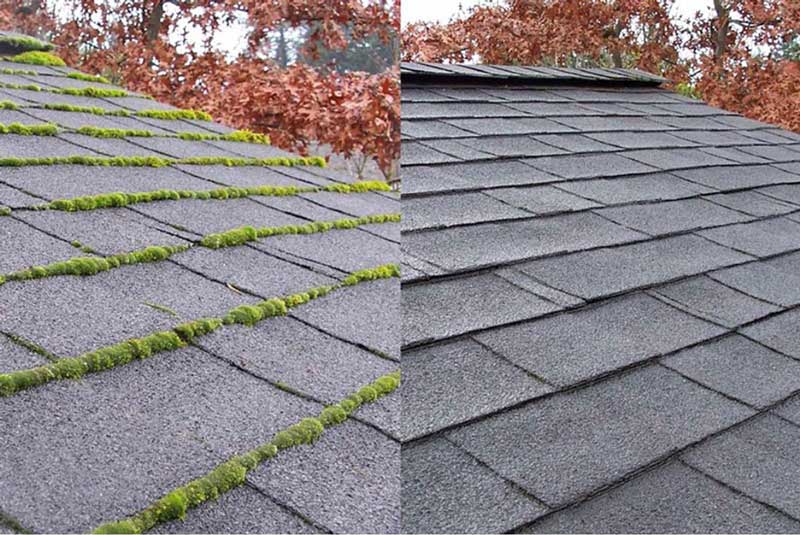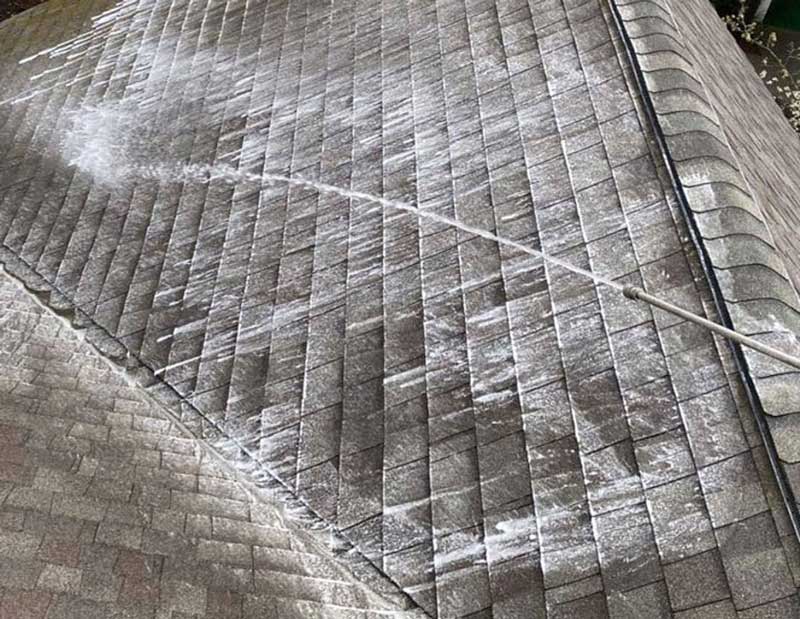Moss Treatment: Liquid vs Granular Options
A moss covered roof may have a quaint aesthetic to it that many people find appealing, but that is really the only good thing about it. If left to take control of the roof of your building, moss can cause serious damage to the shingles of your roof and could ultimately lead to consequences like water damage. With enough time, moss could end up causing the need for a full roof replacement. The good news is that there are great options for moss treatments that can save your roof from being overtaken by moss. There are two main types of moss treatment, liquid and granular, and we’ll take a look at each.

Why Is Moss A Serious Concern?
Is a little moss really that bad? The short answer is yes. The Pacific Northwest has the ideal climate for mosses to flourish. Mosses love damp and cool places to grow. The combination of long periods of light rain and large trees to provide shade makes Portland, and the rest of the Pacific Northwest, a breeding ground for moss. There are a number of ways mosses can damage rooftops, but it really comes down to water. Because mosses don’t have roots to transport water to the plant body, they absorb water through diffusion directly into the plant body. This means that they act like sponges and can absorb and hold up to 20 times they’re weight. Holding moisture closely to shingles can cause them to deteriorate more quickly than they normally would. If moss were to get under a shingle, the shingle would be lifted which would allow water to leach underneath, rendering the shingle useless. A buildup of moss can create dams on your roof, increasing the likelihood of leaks. One of the biggest threats to your roof is the changing of the seasons. Moss left on a roof through winter will amplify the freeze/ thaw effect, and can be quickly leave roofs vulnerable to weathering, deterioration, leaks and water damage. If left unchecked, it can cause serious harm to the structural integrity of the building.
Granular Moss Treatments
A popular choice when treating roofs for moss is a granular treatment. They are applied by spreading powder in lines along the roof in regular spacings of two to four feet. This option requires rain to work properly. When the rain falls, it dissolves the powder and runs down the roof to the eaves. This option generally takes about a week to observe results. There are a few downsides to using granular treatments, the first being that it requires rain for the treatment to work effectively. This means a couple things; first, this treatment option is highly seasonal and can only be applied in times of consistent rain, and second, because it takes time for the treatment to dissolve, you run the risk of the treatment being blown away by wind before it ever actually gets dissolved, making the effort useless. Another downside of granular treatments is that they can be difficult to apply evenly. This can end up leaving spots that have little to no treatment applied. In order to properly apply granular treatments, you’ll need to walk across your entire roof, increasing the risk of injury from an accident. Granular Treatments have also been known to leave white streaks due to the powder not fully dissolving.
Liquid Moss Treatments

Liquid treatments eliminate a lot of the downsides associated with granular treatments. Liquid options don’t rely on the rain to function correctly, meaning that it can be applied all year round. This also means that once the treatment is applied, you don’t need to worry about the wind blowing away your effort or worry about white streaks. It is much easier to apply liquid treatments evenly across your roof for full coverage. Also, because the treatment is applied through a hose, this really limits how much you’ll need to walk on the roof, making it a safer option. One thing to consider with liquid treatments is that certain communities may have restrictions about how to dispose of treatment runoff, and don’t allow it to drain into storm drains. If you are unsure about the regulations in your location, you can always check in with your local government or, better yet, call in the pros!
SNUGS has been treating and removing moss for many years and only uses the best treatments. We are approved by the Department of Agriculture to apply treatments and remove moss. We use compounds that are registered with the EPA, and are proven to turn the moss inert, which is applied in liquid form. Whether your roof is Metal, Tile, Slate, Composition, or Cedar Shake, we can remove the moss. SNUGS has been removing moss from roofs for many years and has come across all different types of roofs. Some roofs need to be pressure washed, while other roofs will be destroyed from pressure washing. We can handle either situation and do the best to keep your roof in good condition. Once we clean the moss off the roof, we will clean the gutters and clean the moss from the ground. On composition roofs we will apply granular treatment to help prevent any roots or spores from continuing to grow.
Snugs Pro Wash, Inc, dba SNUGS Services, has been providing high quality Pressure Washing Services in Portland, OR since 1995. Started as a residential pressure washing and roof cleaning service, SNUGS is now one of the leading exterior cleaning companies in the Northwest. From our humble beginnings as a man with a truck and a trailer we have grown to become a multi-million dollar company serving corporate customers, name brands, and mom and pop companies alike.